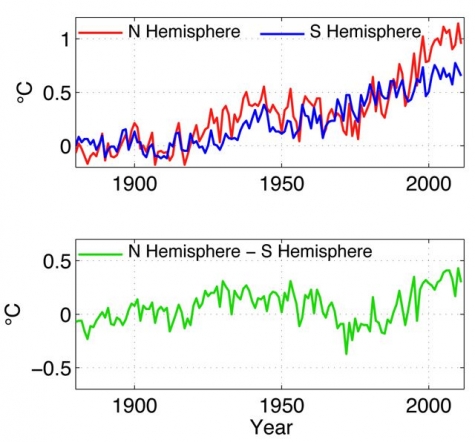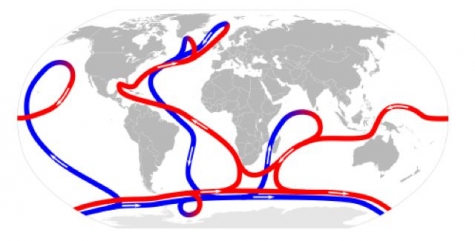In Warming, Northern Hemisphere is Outpacing the South
If global warming were a race, the Northern Hemisphere would be winning. It is warming faster than the Southern Hemisphere, with some of the most rapid warming rates on Earth located in the Arctic, where sea and land ice is shrinking and thinning. Not only is the North winning now, but projections show that, largely due to the influence of manmade greenhouse gas emissions, it is likely to widen its lead in the coming decades.
Two new studies shed light on this disparity, and how it could have profound consequences for tropical rainfall.
 According to one of the studies, by a group of researchers based at U.C. Berkeley and the University of Washington, the Northern Hemisphere has led the Southern Hemisphere in its rate of warming since about 1980, largely because the Northern Hemisphere has more land and less ocean than the Southern Hemisphere, and oceans warm relatively slowly. Prior to 1980, the long-term trend that would have been there from increased greenhouse gases during the 20th century was essentially cancelled out by man-made aerosol emissions, which mostly cooled the Northern Hemisphere, the study found.
According to one of the studies, by a group of researchers based at U.C. Berkeley and the University of Washington, the Northern Hemisphere has led the Southern Hemisphere in its rate of warming since about 1980, largely because the Northern Hemisphere has more land and less ocean than the Southern Hemisphere, and oceans warm relatively slowly. Prior to 1980, the long-term trend that would have been there from increased greenhouse gases during the 20th century was essentially cancelled out by man-made aerosol emissions, which mostly cooled the Northern Hemisphere, the study found.
The second study, by researchers at the Potsdam Institute for Climate Impact Research in Germany, implicates global ocean currents as another factor contributing to the Northern Hemisphere’s warming lead. These currents transport heat away from southern waters and into the North Atlantic and North Pacific, helping to warm nearby land areas in the north even more.
The Gulf Stream, which flows from southwest to northeast off the U.S. East Coast, is among the most well-known currents which actually can trace some of its roots to the Southern Hemisphere.
In an “emerging indicator” of global warming, both studies found that the temperature difference between the two hemispheres has grown since 1980, and climate model projections show the Northern Hemisphere will continue to pull away from its hemispheric counterpart in the coming decades. The exact magnitude of the temperature difference will depend on the emissions of greenhouse gases, among other factors.
 “Global warming is not even in the two hemispheres, and that is expected to continue and continue to increase along with the global temperatures,” said Andrew R. Friedman, a geography graduate student at U.C. Berkeley and the study’s lead author.
“Global warming is not even in the two hemispheres, and that is expected to continue and continue to increase along with the global temperatures,” said Andrew R. Friedman, a geography graduate student at U.C. Berkeley and the study’s lead author.
The Berkeley study projected that if emissions remain on their present upward trajectory, the average temperature difference between the two hemispheres could be about 1.6°C, or about 3°F. This would be sufficient to alter tropical rainfall patterns, which could affect everything from rice cultivation in India to the health of the Amazon Rainforest.
Friedman and his co-author, geography professor John Chiang, found that as the Northern Hemisphere warms up at a relatively faster rate, tropical rain bands that form near the equator, where trade winds collide to build towering thunderstorms, may shift northward, drying out parts of the Southern Hemisphere.
This zone of tropical rainfall is known as the Intertropical Convergence Zone, or ITCZ, and its location helps influence weather patterns worldwide, even playing a key role in the North Atlantic hurricane season. Many hurricanes begin as areas of thunderstorms along the ITCZ.
When the ITCZ’s average location changes, it can drastically alter rainfall in equatorial countries. The seasonal shifts in the ITCZ help drive the dry and rainy seasons in the tropics, while longer-lasting changes can mean damaging floods for some, and withering drought for others.
While the study found that tropical rainfall might shift, the authors could not yet pinpoint the most likely reason. It could be due to the response of the climate to warmer conditions, since warmer air carries more water vapor, or it could be related to the interhemispheric temperature differences, or both, Friedman said in an interview.
“There is a tendency [for tropical rainfall] to shift northward, but it is very difficult to look at specific areas,” Friedman said.
Chiang said that recent research shows that tropical rain bands tend to favor the warmer hemisphere, so it makes sense that as the Northern Hemisphere warms faster, the rains which drive agriculture-sustaining monsoons may shift that way too.
“We’re trying to promote a new way of thinking about how tropical rainfall might change in the future,” he said, adding that this is an area of evolving, active scientific research.
Two new studies shed light on this disparity, and how it could have profound consequences for tropical rainfall.
 According to one of the studies, by a group of researchers based at U.C. Berkeley and the University of Washington, the Northern Hemisphere has led the Southern Hemisphere in its rate of warming since about 1980, largely because the Northern Hemisphere has more land and less ocean than the Southern Hemisphere, and oceans warm relatively slowly. Prior to 1980, the long-term trend that would have been there from increased greenhouse gases during the 20th century was essentially cancelled out by man-made aerosol emissions, which mostly cooled the Northern Hemisphere, the study found.
According to one of the studies, by a group of researchers based at U.C. Berkeley and the University of Washington, the Northern Hemisphere has led the Southern Hemisphere in its rate of warming since about 1980, largely because the Northern Hemisphere has more land and less ocean than the Southern Hemisphere, and oceans warm relatively slowly. Prior to 1980, the long-term trend that would have been there from increased greenhouse gases during the 20th century was essentially cancelled out by man-made aerosol emissions, which mostly cooled the Northern Hemisphere, the study found.The second study, by researchers at the Potsdam Institute for Climate Impact Research in Germany, implicates global ocean currents as another factor contributing to the Northern Hemisphere’s warming lead. These currents transport heat away from southern waters and into the North Atlantic and North Pacific, helping to warm nearby land areas in the north even more.
The Gulf Stream, which flows from southwest to northeast off the U.S. East Coast, is among the most well-known currents which actually can trace some of its roots to the Southern Hemisphere.
In an “emerging indicator” of global warming, both studies found that the temperature difference between the two hemispheres has grown since 1980, and climate model projections show the Northern Hemisphere will continue to pull away from its hemispheric counterpart in the coming decades. The exact magnitude of the temperature difference will depend on the emissions of greenhouse gases, among other factors.
 “Global warming is not even in the two hemispheres, and that is expected to continue and continue to increase along with the global temperatures,” said Andrew R. Friedman, a geography graduate student at U.C. Berkeley and the study’s lead author.
“Global warming is not even in the two hemispheres, and that is expected to continue and continue to increase along with the global temperatures,” said Andrew R. Friedman, a geography graduate student at U.C. Berkeley and the study’s lead author.The Berkeley study projected that if emissions remain on their present upward trajectory, the average temperature difference between the two hemispheres could be about 1.6°C, or about 3°F. This would be sufficient to alter tropical rainfall patterns, which could affect everything from rice cultivation in India to the health of the Amazon Rainforest.
Friedman and his co-author, geography professor John Chiang, found that as the Northern Hemisphere warms up at a relatively faster rate, tropical rain bands that form near the equator, where trade winds collide to build towering thunderstorms, may shift northward, drying out parts of the Southern Hemisphere.
This zone of tropical rainfall is known as the Intertropical Convergence Zone, or ITCZ, and its location helps influence weather patterns worldwide, even playing a key role in the North Atlantic hurricane season. Many hurricanes begin as areas of thunderstorms along the ITCZ.
When the ITCZ’s average location changes, it can drastically alter rainfall in equatorial countries. The seasonal shifts in the ITCZ help drive the dry and rainy seasons in the tropics, while longer-lasting changes can mean damaging floods for some, and withering drought for others.
While the study found that tropical rainfall might shift, the authors could not yet pinpoint the most likely reason. It could be due to the response of the climate to warmer conditions, since warmer air carries more water vapor, or it could be related to the interhemispheric temperature differences, or both, Friedman said in an interview.
“There is a tendency [for tropical rainfall] to shift northward, but it is very difficult to look at specific areas,” Friedman said.
Chiang said that recent research shows that tropical rain bands tend to favor the warmer hemisphere, so it makes sense that as the Northern Hemisphere warms faster, the rains which drive agriculture-sustaining monsoons may shift that way too.
“We’re trying to promote a new way of thinking about how tropical rainfall might change in the future,” he said, adding that this is an area of evolving, active scientific research.
You can return to the main Market News page, or press the Back button on your browser.

